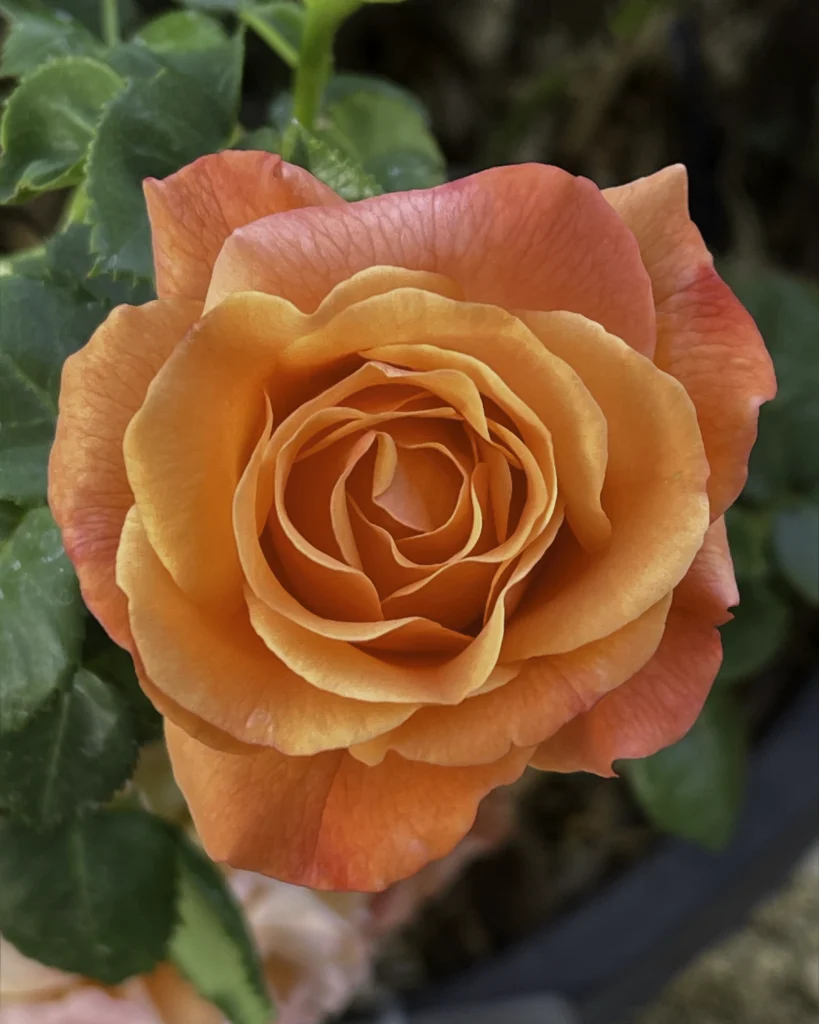This summer has really highlighted the importance of mulching our roses. With the Phoenix area experiencing over 110 days of temperatures exceeding 100 degrees, I’m feeling worn out, and I can only imagine my roses are equally fed up with the heat. Thankfully, I made sure to mulch my plants well this spring.
While a photo of mulch would have suited a discussion on why we mulch our roses, I felt that an image of Pumpkin Patch (WEKmongros) was more appealing than my shot of a wheelbarrow filled with dark mulch.
There is something about the aroma of fresh mulch that lifts my spirits. While I may not derive much pleasure while shoveling mulch into my rose beds, I appreciate its visual appeal and the rich, earthy scent it emits. The ultimate reward lies in the garden beds’ transformed appearance and the plants’ revitalized vigor, which thrive under a new layer of mulch.
Mulch can be any material spread over a garden bed to minimize evaporation, keep the soil temperature stable, and inhibit weed growth. A good mulch provides many advantages in our hot desert climate.
Reasons to Mulch Your Roses
1. Mulching helps maintain cooler soil temperatures during hot summer days, providing roses with a more stable growing environment.
2. It helps maintain a more consistent soil temperature at the base, reducing the impact of temperature fluctuations on the plant.
3. Helps conserve water by slowing evaporation.
4. Its loose structure allows for the easy in and out movement of air, water, and soil gases.
5. Organic mulch breaks down slowly and enriches the soil.
6. It hinders the growth of weeds, making any that appear simpler to remove.
7. Mulch enhances the appeal of a rose bed by providing a neutral backdrop that highlights the roses’ beauty. (Especially important for those of us to take a lot of rose pictures)
My mulch of choice has typically been shredded cedar bark or composted mulch. It’s surprising how fast my thick layer of mulch breaks down each season. I was recently looking and it appears my mulch has shrunk by more than one-inch since March. It seems the earth has a big mouth, and it’s more than happy to chow down on whatever organic material provided to create nutrients for our roses survival.
Mulch can be classified into two main types: organic and inorganic. Organic mulch consists of materials that were once living, such as bark, wood shavings, leaves, straw, or even paper. In contrast, inorganic mulch primarily includes rocks, typically found as gravel, or the rubber mulch that you can find in the big box stores.
A Brief Word About Non-Organic Mulches
Inorganic mulches do not enhance soil fertility or its composition. Common examples include gravel, stones, clay aggregates, and ground rubber tires. Non-organic mulches tend to cause greater fluctuations in soil temperature than their organic counterparts. The air layer just above non-organic mulch tends to be warmer than that above organic mulch, potentially creating a more favorable environment for spider mites on rose bush leaves.
Save the inorganic mulches for walkway, not your rose beds. Mulches that raise soil temperature may benefit cooler parts of the world by extending the growing season. However, they are generally impractical in a hot desert environment like most of Arizona.
Organic Mulches Are Better For Your Roses
A better type of mulch is something that will break down to enrich the soil with its organic matter.
Bark chunks, available in many forms and sizes, are attractive and allow good water, air, and fertilizer percolation. They may seem expensive at first, but they can last many years. Because they are slower to decompose, nitrogen should be added to prevent the soil from depriving itself of nitrogen during decomposition.
Compost, whether made at home or purchased, is beneficial for improving soil structure. It may require occasional turning to avoid hardening. Look for trustworthy sources that provide information on their compost’s ingredients and production methods. An excellent place to start is to review the UofA Cooperative Extension’s publication “Using Mulch in the Landscape” (https://extension.arizona.edu/sites/extension.arizona.edu/files/attachment/Mulches.pdf)
Chopped alfalfa hay is known for its numerous benefits as it decomposes. Some gardeners use alfalfa meal. When you visit the feed store, be sure to ask for the old hay or soiled stray because you’re not going to be using it for feed.
Shredded newspaper is a cost-effective mulch option, provided you take some precautions. Since most newspapers are printed with organic inks, there’s no need to worry about lead contamination. However, it’s best to avoid waxed cardboard and glossy materials like magazines. Be sure to remove any packing tape and staples from boxes.
Sawdust, while good in color, may tend to become soggy or mat, which lessens good air circulation. Because sawdust decomposes slowly, it’s important to add nitrogen to avoid depleting the soil’s nitrogen levels during the breakdown process.
In essence, mulch is a comforting blanket that protects your precious roses from large swings in temperature, and it conserves water by slowing evaporation. Mulching could make caring for your plants easier, promote healthier growth, and yield more beautiful roses!



